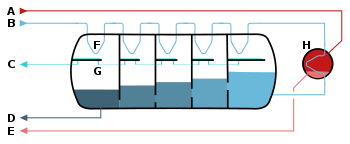Multi-stage flash distillation (MSF) is a water desalination process that distills sea water by flashing a portion of the water into steam in multiple stages of what are essentially countercurrent heat exchangers. Current MSF facilities may have as many as 30 stages.[1]
Multi-stage flash distillation plants produce about 26% of all desalinated water in the world, but almost all of new desalination plants currently use reverse osmosis due to much lower energy consumption.[2]


The plant has a series of spaces called stages, each containing a heat exchanger and a condensate collector. The sequence has a cold end and a hot end while intermediate stages have intermediate temperatures. The stages have different pressures corresponding to the boiling points of water at the stage temperatures. After the hot end there is a container called the brine heater.[citation needed]
The process goes through the following steps:
The total evaporation in all the stages is up to approximately 85% of the water flowing through the system, depending on the range of temperatures used. With increasing temperature there are growing difficulties of scale formation and corrosion. 110-120 °C appears to be a maximum, although scale avoidance may require temperatures below 70 °C.[4]
The feed water carries away the latent heat of the condensed steam, maintaining the low temperature of the stage. The pressure in the chamber remains constant as equal amounts of steam is formed when new warm brine enters the stage and steam is removed as it condenses on the tubes of the heat exchanger. The equilibrium is stable, because if at some point more vapor forms, the pressure increases and that reduces evaporation and increases condensation.[citation needed]
In the final stage, the brine and the condensate has a temperature near the inlet temperature. Then the brine and condensate are pumped out from the low pressure in the stage to the ambient pressure. The brine and condensate still carry a small amount of heat that is lost from the system when they are discharged. The heat that was added in the heater makes up for this loss.[citation needed]
The heat added in the brine heater usually comes in the form of hot steam from an industrial process co-located with the desalination plant. The steam is allowed to condense against tubes carrying the brine (similar to the stages).[citation needed]
The energy that makes possible the evaporation is all present in the brine as it leaves the heater. The reason for letting the evaporation happen in multiple stages rather than a single stage at the lowest pressure and temperature, is that in a single stage, the feed water would only warm to an intermediate temperature between the inlet temperature and the heater, while much of the steam would not condense and the stage would not maintain the lowest pressure and temperature.[citation needed]
Such plants can operate at 23–27 kWh/m3 (appr. 90 MJ/m3) of distilled water.[5]
Because the colder salt water entering the process counterflows with the saline waste water/distilled water, relatively little heat energy leaves in the outflow—most of the heat is picked up by the colder saline water flowing toward the heater and the energy is recycled.
In addition, MSF distillation plants, especially large ones, are often paired with power plants in a cogeneration configuration. Waste heat from the power plant is used to heat the seawater, providing cooling for the power plant at the same time. This reduces the energy needed by half to two-thirds, which drastically alters the economics of the plant, since energy is by far the largest operating cost of MSF plants. Reverse osmosis, MSF distillation's main competitor, requires more pretreatment of the seawater and more maintenance, as well as energy in the form of work (electricity, mechanical power) as opposed to cheaper low-grade waste heat.[6][7]
{{cite journal}}: Cite journal requires |journal= (help)